Performance Evaluation of Grid-Connected Photovoltaic System Under Climatic Conditions of Isthmus of Tehuantepec
Abstract
1. Introduction
2. Materials and Methods
2.1. Solar Resource Potential and Photovoltaic System
2.2. Determination of Normalized Yields
2.3. Power Quality Analysis
3. Results
3.1. Analysis of Climatological Conditions
3.2. System Performance Analysis
3.3. Power Quality Analysis
4. Conclusions
Supplementary Materials
Author Contributions
Funding
Data Availability Statement
Acknowledgments
Conflicts of Interest
References
- Xu, X.; Hu, J.; Zhang, H.; Feng, Y.; Yang, J.; Tan, Z.; Bai, J. Photovoltaic resource assessment through roof usable area extraction based on image segmentation. Sol. Energy 2025, 297, 113646. [Google Scholar] [CrossRef]
- REN21. Renewables Global Status Report collection, Renewables in Energy Supply. 2024. Available online: https://www.ren21.net/wp-content/uploads/2019/05/GSR2024_Supply.pdf (accessed on 15 November 2025).
- Global Electricity Review 2023, EMBER. Available online: https://ember-climate.org/insights/research/global-electricity-review-2023/ (accessed on 5 July 2025).
- Hamid, A.K.; Mbungu, N.T.; Elnady, A.; Bansal, R.C.; Ismail, A.A.; AlShabi, M.A. A systematic review of grid-connected photovoltaic and photovoltaic/thermal systems: Benefits, challenges and mitigation. Energy Environ. 2022, 34, 2775–2814. [Google Scholar] [CrossRef]
- Schetinger, A.M.; de Lucena, A.F.P. Evaluating Policy Frameworks and Their Role in the Sustainable Growth of Distributed Photovoltaic Generation. Resources 2025, 14, 28. [Google Scholar] [CrossRef]
- De Lima, G.C.; Toledo, A.L.L.; Bourikas, L. The Role of National Energy Policies and Life Cycle Emissions of PV Systems in Reducing Global Net Emissions of Greenhouse Gases. Energies 2021, 14, 961. [Google Scholar] [CrossRef]
- Breyer, C.; Koskinen, O.; Blechinger, P. Profitable climate change mitigation: The case of greenhouse gas emission reduction benefits enabled by solar photovoltaic systems. Renew. Sustain. Energy Rev. 2015, 49, 610–628. [Google Scholar] [CrossRef]
- Basit, M.A.; Dilshad, S.; Badar, R.; Sami ur Rehman, S.M. Limitations, challenges, and solution approaches in grid-connected renewable energy systems. Int. J. Energy Res. 2020, 44, 4132–4162. [Google Scholar] [CrossRef]
- International Energy Agency. World Energy Outlook 2020. October 2020. Available online: https://iea.blob.core.windows.net/assets/a72d8abf-de08-4385-8711-b8a062d6124a/WEO2020.pdf (accessed on 15 November 2025).
- United Nations. Transforming Our World: The 2030 Agenda for Sustainable Development. 2015. Available online: https://docs.un.org/es/A/RES/70/1 (accessed on 15 November 2025).
- Etukudoh, E.A.; Sikhakhane Nwokediegwu, Z.Q.; Akpan Umoh, A.; Ifeanyi Ibekwe, K.; Ikenna Ilojianya, V.; Adefemi, A. Solar power integration in Urban areas: A review of design innovations and efficiency enhancements. World J. Adv. Res. Rev. 2024, 21, 1383–1394. [Google Scholar] [CrossRef]
- Biancardi, A.; Califano, F.; D’Adamo, I.; Gastaldi, M.; Kostakis, I. A distributed and sustainable model for future cities: A profitability analysis of integrated photovoltaic systems with storage under different incentive policies. Energy Policy 2025, 205, 114691. [Google Scholar] [CrossRef]
- Rehman, U.; Faria, P.; Gomes, L.; Vale, Z. Future of energy management systems in smart cities: A systematic literature review. Sustain. Cities Soc. 2023, 96, 104720. [Google Scholar] [CrossRef]
- International Energy Agency. Renewables 2021—Analysis; IEA: Paris, France, 2021. [Google Scholar]
- Woyte, A.; Richter, M.; Moser, D.; Reich, N.; Green, M.; Mau, S.; Beyer, H.G. Analytical Monitoring of Grid-Connected Photovoltaic Systems Good Practices for Monitoring and Performance Analysis; IEA: Paris, France, 2014; Task 13, Subtask 2 Report IEA-PVPS T13-03: 2014. [Google Scholar]
- Lindig, S.; Deckx, J.; Herz, M.; Vásquez, J.A.; Theristis, M.; Herteleer, B.; Anderson, K. Best Practice Guidelines for the Use of Economic and Technical KPIs; Sandia National Lab: Albuquerque, NM, USA, 2024; 2024 IEA-PVPS T13-28:2024. [Google Scholar]
- Ahmad Mohd, K.; Indradip, M.; Werner, W.; Volker, S. Performance ratio—Crucial parameter for grid connected PV plants. Renew. Sustain. Energy Rev. 2016, 65, 1139–1158. [Google Scholar] [CrossRef]
- Decker, B.; Jahn, U. Performance of 170 grid connected PV plants in northern Germany—Analysis of yields and optimization potentials. Sol. Energy 1997, 59, 127–133. [Google Scholar] [CrossRef]
- Jahn, U.; Nasse, W. Operational performance of grid-connected PV systems on buildings in Germany. Prog. Photovolt. Res. Appl. 2004, 12, 441–448. [Google Scholar] [CrossRef]
- Jahn, U.; Nasse, W.; Nordmann, T.; Clavadetscher, L.; Mayer, D. Achievements of task 2 of IEA PV power systems programme: Final results on PV system performance. In Proceedings of the 19th EUPVSEC, Paris, France, 7–11 June 2004; pp. 2813–2816. [Google Scholar]
- Iqbal, S.; Khan, S.N.; Sajid, M.; Khan, J.; Ayaz, Y.; Waqas, A. Impact and performance efficiency analysis of grid-tied solar photovoltaic system based on installation site environmental factors. Energy Environ. 2022, 34, 2343–2363. [Google Scholar] [CrossRef]
- Meflah, A.; Chekired, F.; Drir, N.; Canale, L. Accurate Method for Solar Power Generation Estimation for Different PV (Photovoltaic Panels) Technologies. Resources 2024, 13, 166. [Google Scholar] [CrossRef]
- Gonzalez, D.; Ramos Paja, C.A.; Saavedra Montes, A.J.; Arango Zuluaga, E.I.; Carrejo, C.E. Modeling and control of grid connected photovoltaic systems. Rev. Fac. Ing. Antioquia 2012, 62, 145–156. [Google Scholar]
- Roumpakias, E.; Stamatelos, T. Surface Dust and Aerosol Effects on the Performance of Grid-Connected Photovoltaic Systems. Sustainability 2020, 12, 569. [Google Scholar] [CrossRef]
- Kazem, H.A.; Chaichan, M.T.; Al-Waeli, A.H.; Sopian, K. A novel model and experimental validation of dust impact on grid-connected photovoltaic system performance in Northern Oman. Sol. Energy 2020, 206, 564–578. [Google Scholar] [CrossRef]
- Ramanan, P.; Karthick, A. Performance analysis and energy metrics of grid-connected photovoltaic systems. Energy Sustain. Dev. 2019, 52, 104–115. [Google Scholar] [CrossRef]
- Talaat, M.; Farahat, M.A.; Elkholy, M.H. Renewable power integration: Experimental and simulation study to investigate the ability of integrating wave, solar and wind energies. Energy 2019, 170, 668–682. [Google Scholar] [CrossRef]
- Waterworth, D.; Armstrong, A. Southerly winds increase the electricity generated by solar photovoltaic systems. Sol. Energy 2020, 202, 123–135. [Google Scholar] [CrossRef]
- Dhaundiyal, A.; Atsu, D. The effect of wind on the temperature distribution of photovoltaic modules. Sol. Energy 2020, 201, 259–267. [Google Scholar] [CrossRef]
- Ruan, T.; Wang, F.; Topel, M.; Laumert, B.; Wang, W. A new optimal PV installation angle model in high-latitude cold regions based on historical weather big data. Appl. Energy 2024, 359, 122690. [Google Scholar] [CrossRef]
- Guerin, T.F. Evaluating expected and comparing with observed risks on a large-scale solar photovoltaic construction project: A case for reducing the regulatory burden. Renew. Sustain. Energy Rev. 2017, 74, 333–348. [Google Scholar] [CrossRef]
- Paiano, A.; Lagioia, G.; Ingrao, C. A combined assessment of the energy, economic and environmental performance of a photovoltaic system in the Italian context. Sci. Total Environ. 2023, 866, 161329. [Google Scholar] [CrossRef]
- Hysa, B.; Mularczyk, A. PESTEL Analysis of the Photovoltaic Market in Poland—A Systematic Review of Opportunities and Threats. Resources 2024, 13, 136. [Google Scholar] [CrossRef]
- Mani, M.; Pillai, R. Impact of dust on solar photovoltaic (PV) performance: Research status, challenges and recommendations. Renew. Sustain. Energy Rev. 2010, 14, 3124–3131. [Google Scholar] [CrossRef]
- Khatib, T.; Sopian, K.; Kazem, H.A. Actual performance and characteristic of a grid connected photovoltaic power system in the tropics: A short term evaluation. Energy Convers. Manag. 2013, 71, 115–119. [Google Scholar] [CrossRef]
- Tahri, F.; Tahri, A.; Oozeki, T. Performance evaluation of grid-connected photovoltaic systems based on two photovoltaic module technologies under tropical climate conditions. Energy Convers. Manag. 2018, 165, 244–252. [Google Scholar] [CrossRef]
- Guenounou, A.; Malek, A.; Aillerie, M. Comparative performance of PV panels of different technologies over one year of exposure: Application to a coastal Mediterranean region of Algeria. Energy Convers. Manag. 2016, 114, 356–363. [Google Scholar] [CrossRef]
- Owolabi, A.B.; Yakub, A.O.; Li, H.X.; Suh, D. Performance evaluation of two grid-connected solar photovoltaic systems under temperate climatic conditions in South Korea. Energy Rep. 2022, 8, 12227–12236. [Google Scholar] [CrossRef]
- Adrada Guerra, T.; Amador Guerra, J.; Orfao Tabernero, B.; De la Cruz García, G. Comparative Energy Performance Analysis of Six Primary Photovoltaic Technologies in Madrid (Spain). Energies 2017, 10, 772. [Google Scholar] [CrossRef]
- Muñoz-Rodríguez, F.J.; Snytko, A.; De la Casa-Hernandez, J.; Rus-Casas, C.; Jiménez-Castillo, G. Rooftop photovoltaic systems. New parameters for the performance analysis from monitored data based on IEC 61724. Energy Build. 2023, 295, 113280. [Google Scholar] [CrossRef]
- Charfi, W.; Chaabane, M.; Mhiri, H.; Bournot, P. Performance evaluation of a solar photovoltaic system. Energy Rep. 2018, 4, 400–406. [Google Scholar] [CrossRef]
- Maraj Al Kërtusha, X.; Lushnjari, A. Energy performance evaluation for a floating photovoltaic system located on the reservoir of a hydro power plant under the mediterranean climate conditions during a sunny day and a cloudy-one. Energy Convers. Manag. X 2022, 16, 100275. [Google Scholar] [CrossRef]
- Joshi, A.S.; Dincer Ibrahim Reddy, B.V. Performance analysis of photovoltaic systems: A review. Renew. Sustain. Energy Rev. 2009, 13, 1884–1897. [Google Scholar] [CrossRef]
- Ahmed, M.; Abdelrahem, M.; Kennel, R. Highly efficient and robust grid connected photovoltaic system based model predictive control with kalman filtering capability. Sustainability 2020, 12, 4542. [Google Scholar] [CrossRef]
- Ouai, A.; Mokrani, L.; Machmoum, M.; Houari, A. Control and energy management of a large scale grid-connected PV system for power quality improvement. Sol. Energy 2018, 171, 893–906. [Google Scholar] [CrossRef]
- López-Bravo, C.; Mora-López, L.; Sidrach-deCardona, M.; Márquez-Ballesteros, M.J. A comprehensive analysis based on GIS-AHP to minimise the social and environmental impact of the installation of large-scale photovoltaic plants in south Spain. Renew. Energy 2024, 226, 120387. [Google Scholar] [CrossRef]
- Häberlin, H. Photovoltaics: System Design and Practice; John Wiley & Sons: Hoboken, NJ, USA, 2012. [Google Scholar]
- Haeberlin, H. System monitoring. In Photovoltaics in Cold Climates; Routledge: Oxford, UK, 2019. [Google Scholar]
- García, L.V.; García, J.V.; Rayo, C.A.; Rodriguez, G.N.; Milanés, H.F.M. Rendimiento global de sistemas fotovoltaicos conectados a la red eléctrica. Tecnol. Desarro. 2014, 12, 26. [Google Scholar]
- Livera, A.; Theristis, M.; Makrides, G.; Georghiou, G.E. Recent advances in failure diagnosis techniques based on performance data analysis for grid-connected photovoltaic systems. Renew. Energy 2019, 133, 126–143. [Google Scholar] [CrossRef]
- Weber, B.; Magaña-López, R.; Martínez Cienfuegos, I.G.; Durán-García, M.D.; Stadlbaue, E.A. Current status of photovoltaic plants in Mexico—An analysis based on online monitoring. Energy Sustain. Dev. 2020, 57, 48–56. [Google Scholar] [CrossRef]
- Santana-Rodríguez, G.; Vigil-Galan, O.; Jimenez-Olarte, D.; Contreras-Puente, G.; Monroy, B.M.; Escamilla-Esquivel, A. Evaluation of a grid-connected photovoltaic system and in-situ characterization of photovoltaic modules under the environmental conditions of Mexico City. Rev. Mex. Física 2013, 59, 88–94. [Google Scholar]
- Messina, S.; Hernández Rosales, I.P.; Saldaña Durán, C.E.; Quiñones, J.J.; Nair, P.K. Comparative study of system performance of two 2.4 kW grid-connected PV installations in Tepic-Nayarit and Temixco-Morelos in México. Energy Procedia 2014, 57, 161–167. [Google Scholar] [CrossRef]
- Rivera-Martínez, M.A.; Hernández-Galvez, G.; Sarracino-Martínez, O.; Ixtlilco-Cortés, L.; Juantorena-Ugás, A.; Batalla-Nolasco, U.I.; Becerra-García, D. Análisis de sensibilidad de sistemas fotovoltaicos conectados a la red eléctrica: Caso de estudio en Guerrero, México. Ing. Investig. Tecnol. 2017, 18, 293–305. [Google Scholar]
- Acosta-Banda, A.; Aguilar-Esteva, V.; Hechavarría Difur, L.; Campos-Mercado, E.; Cortés-Martínez, B.; Patiño-Ortiz, M. Grid-Connected Photovoltaic Systems as an Alternative for Sustainable Urbanization in Southeastern Mexico. Urban. Sci. 2025, 9, 329. [Google Scholar] [CrossRef]
- ASOLMEX. Asociación Mexicana de Energía Solar. Available online: https://asolmex.org/ (accessed on 5 July 2025).
- Elliott, D.; Schwartz, M.; Scott, G.; Haymes, S.; Heimiller, D.; George, R. Atlas de Recursos Eólicos del Estado de Oaxaca (The Spanish Version of Wind Energy Resource Atlas of Oaxaca) (No. NREL/TP-500-35575); National Renewable Energy Lab. (NREL): Golden, CO, USA, 2004. [Google Scholar]
- Global Solar Atlas. Available online: https://globalsolaratlas.info/map?c=16.241009,-95.323563,10&s=16.32463,-95.24104&m=site (accessed on 1 April 2025).
- Gobierno de México. Available online: https://www.gob.mx/se/acciones-y-programas/corredor-interoceanico-del-istmo-de-tehuantepec?state=published (accessed on 15 November 2025).
- Asociación Mexicana de Energía Eólica, AMDEE. Available online: https://amdee.org/es_es/07-proyectos/ (accessed on 5 July 2025).
- Li, P.; Lian, J.; Ma, C.; Zhang, J. Complementarity and development potential assessment of offshore wind and solar resources in China seas. Energy Convers. Manag. 2023, 296, 117705. [Google Scholar] [CrossRef]
- Choi, Y.; Suh, J.; Sung-Min, K. GIS-Based Solar Radiation Mapping, Site Evaluation, and Potential Assessment: A Review. Appl. Sci. 2019, 9, 1960. [Google Scholar] [CrossRef]
- Molina Pfennig, P.; González-Baheza, A. Evaluación de los recursos de radiación solar en los municipios de Baja California Sur, México, mediante un modelo de aptitud socioambiental. Región Soc. 2020, 32, 1–37. [Google Scholar] [CrossRef]
- Flores Meza, A. Ajuste de un concentrador solar de canal parabólico a partir de su reconstrucción geométrica. Temas Cienc. Tecnol. 2016, 20, 43–48. Available online: http://repositorio.utm.mx:8080/jspui/handle/123456789/325 (accessed on 12 September 2025).
- Duffie, J.A.; Beckman, W.A. Solar Engineering of Thermal Processes; John Wiley & Sons, Inc.: Hoboken, NJ, USA, 2013. [Google Scholar]
- Mexican Energy Regulatory Commission (CRE). General Administrative Provisions Containing the Criteria of Efficiency, Quality, Reliability, Continuity, Security and Sustainability of the National Electric System: Grid Code, as Provided in Article 12, Section XXXVII of the Electricity Industry Law. Published in the Mexico Official Gazette of the Federation on 31 December 2021. Available online: https://www.dof.gob.mx/nota_detalle.php?codigo=5639920&fecha=31/12/2021#gsc.tab=0 (accessed on 20 July 2025).
- Mexico Secretariat of Energy (SENER). Manual for the Interconnection of Power Generation Plants with a Capacity of Less than 0.5 MW. Published in the Mexico Official Gazette of the Federation on 15 December 2016. Available online: https://www.cofemersimir.gob.mx/portales/resumen/41183 (accessed on 23 October 2025).
- Federal Electricity Commission (CFE). Multifunction Meters for Electrical Systems. CFE Specification G0000-48, May 2010. Available online: https://studylib.es/doc/9331492/cfe-medidores (accessed on 15 November 2025).
- Urbazaev, M.; Thiel, C.; Cremer, F.; Dubayah, R.; Migliavacca, M.; Reichstein, M.; Schmullius, C. Estimation of forest aboveground biomass and uncertainties by integration of field measurements, airborne LiDAR, and SAR and optical satellite data in Mexico. Carbon Balance Manag. 2018, 13, 5. [Google Scholar] [CrossRef]
- Ahmed, F. Towards an equitable transition: Renewable energy effect on educational outcomes in Canadian communities. Renew. Energy 2026, 256, 124250. [Google Scholar] [CrossRef]
- Blečić, I.; Carrus, A.S.; Congiu, E.; Desogus, G.; Muroni, E.; Saiu, V. Renewable energy communities design: A decision support tool for integrated impact assessment. Insights from the first REC in Cagliari, Italy. J. Clean. Prod. 2025, 510, 145600. [Google Scholar] [CrossRef]
- Rumbayan, M.; Kindangen, J.; Sambul, A.; Sompie, S.; Cross, J. Solar energy implementation in rural communities and its contributions to SDGs: A systematic literature review. Unconv. Resour. 2025, 6, 100180. [Google Scholar] [CrossRef]
- Xu, K.; Nabirye, S.; Sandler, S. Community Solar Policy Landscape and Pathways to Meaningful Benefits: A Review of Equitable Access and Household Savings; (Technical Report NREL/TP-6A20-90868); National Renewable Energy Laboratory: Golden, CO, USA, 2024. Available online: https://www.nrel.gov/docs/fy24osti/90868.pdf (accessed on 5 November 2025).
- Iqbal, A.; Haider, R.; Yasar, A.; Nizami, A.-S. A governance model for sustainable municipal solid waste management: Aligning the sector with Pakistan’s economic goals. Waste Manag. Bull. 2025, 3, 107–127. [Google Scholar] [CrossRef]
- Omole, F.O.; Olajiga, O.K.; Olatunde, T.M. Challenges and successes in rural electrification: A review of global policies and case studies. Eng. Sci. Technol. J. 2024, 5, 1031–1046. Available online: https://www.researchgate.net/publication/379256039_CHALLENGES_AND_SUCCESSES_IN_RURAL_ELECTRIFICATION_A_REVIEW_OF_GLOBAL_POLICIES_AND_CASE_STUDIES (accessed on 10 November 2025). [CrossRef]
- Lucchi, E. Integration between photovoltaic systems and cultural heritage: A socio-technical comparison of international policies, design criteria, applications, and innovation developments. Energy Policy 2022, 171, 113303. [Google Scholar] [CrossRef]
- Lucchi, E.; Adami, J.; Stawinoga, A.E. Social acceptance of photovoltaic systems in heritage buildings and landscapes: Exploring barriers, benefits, drivers, and challenges for technical stakeholders in northern Italy. Sustain. Energy Technol. Assess. 2023, 60, 103544. [Google Scholar] [CrossRef]
- Suri, D.; Shekhar, J.; Mukherjee, A.; Bajaj, A.S. Designing Microgrids for Rural Communities: A Practitioner Focused Mini-Review. In Proceedings of the 2020 IEEE International Conference on Environment and Electrical Engineering and 2020 Industrial and Commercial Power Systems Europe (EEEIC/ICPSEurope), Madrid, Spain, 9–12 June 2020. [Google Scholar] [CrossRef]
- Shivashankar, S.; Mekhilef, S.; Mokhlis, H.; Karimi, M. Mitigating methods of power fluctuation of photovoltaic (PV) sources—A review. Renew. Sustain. Energy Rev. 2024, 59, 1170–1184. [Google Scholar] [CrossRef]

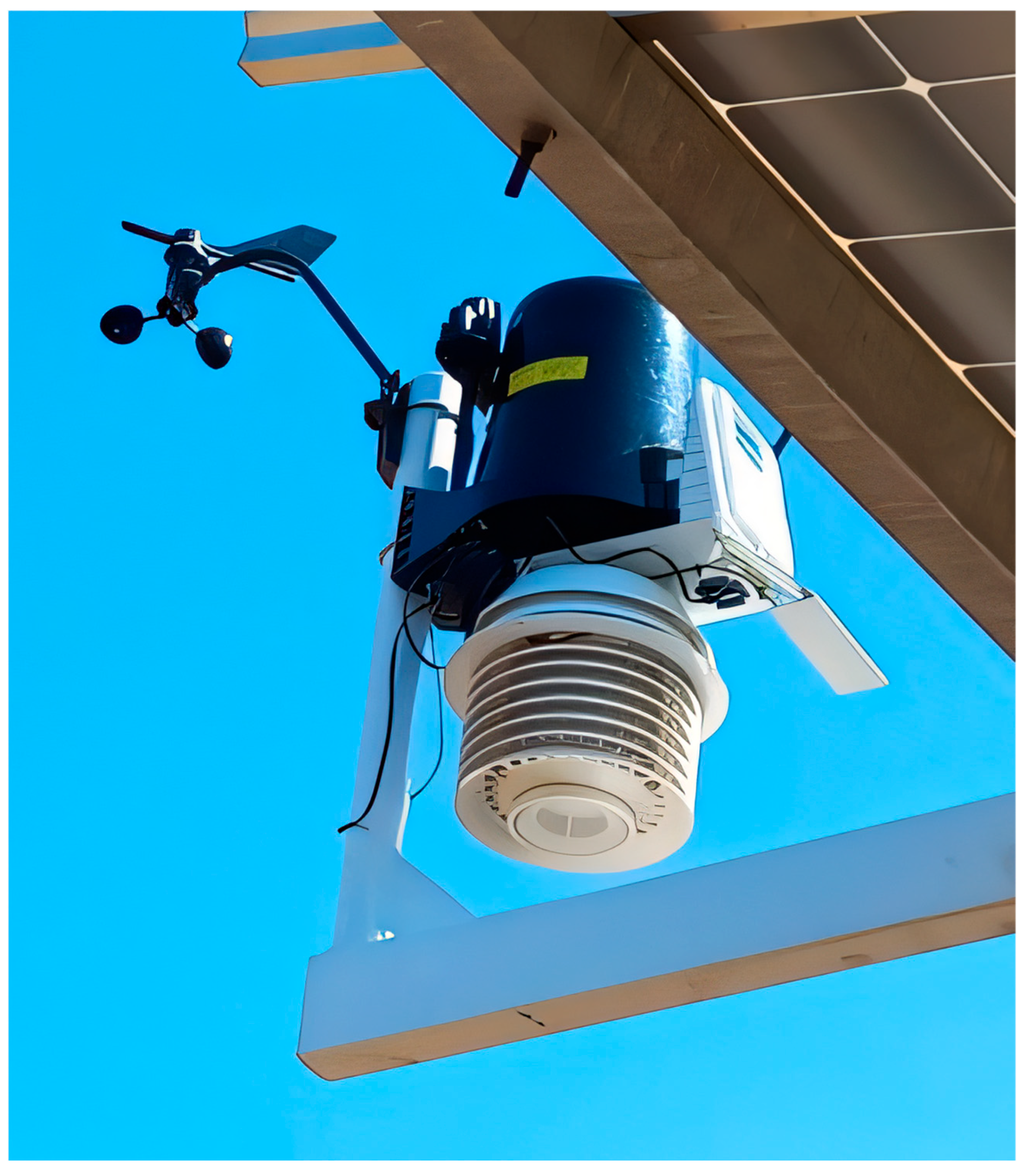
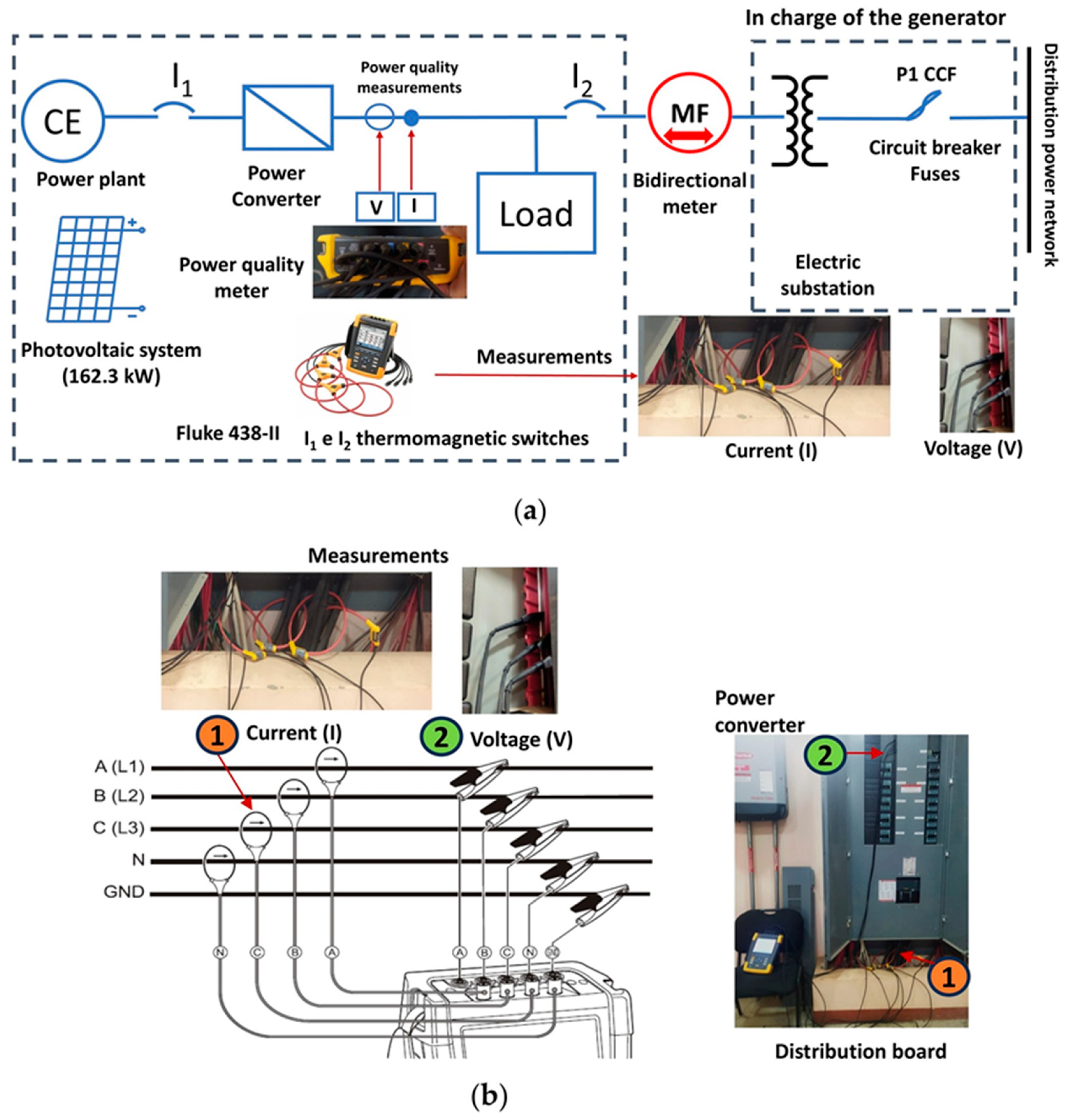
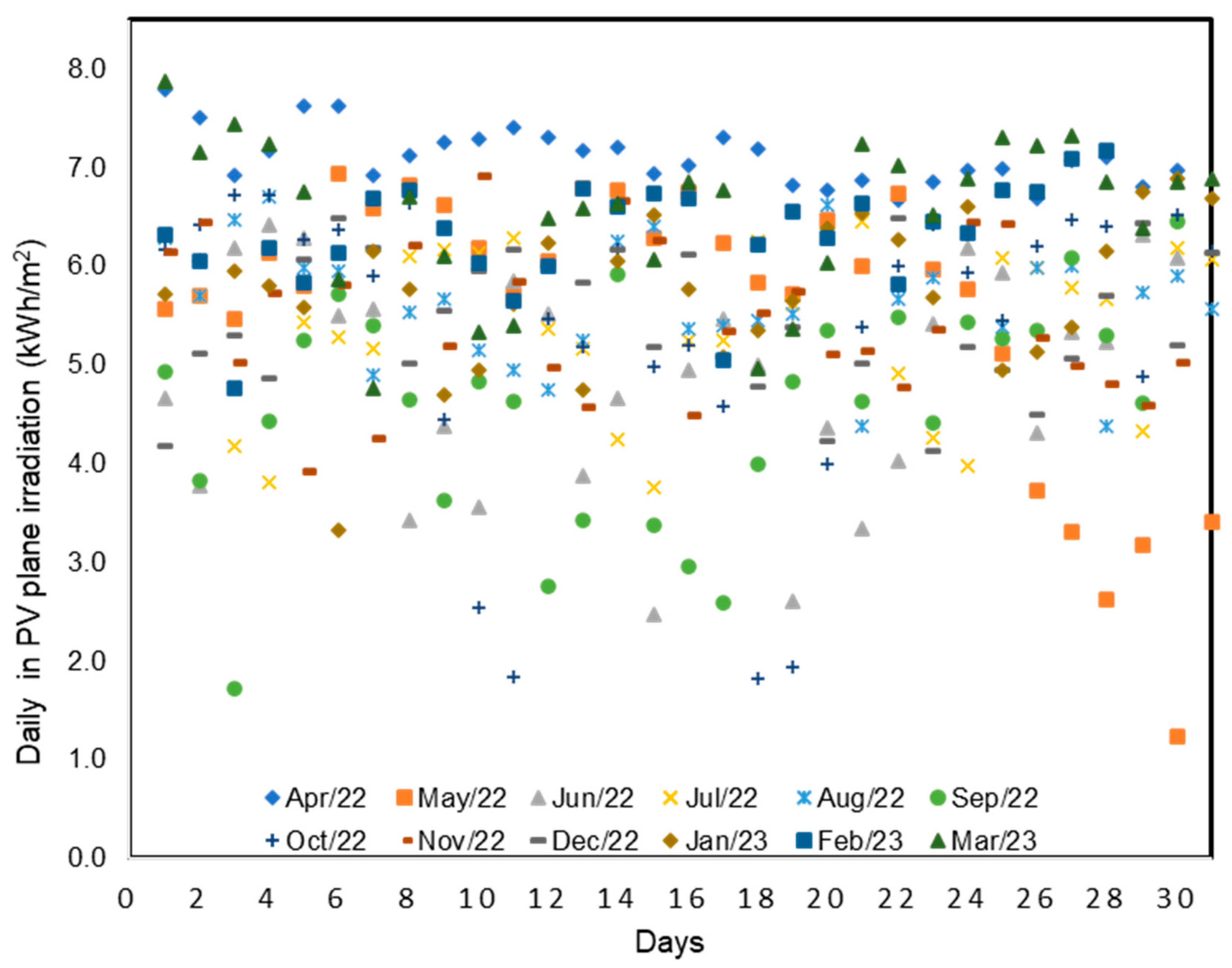

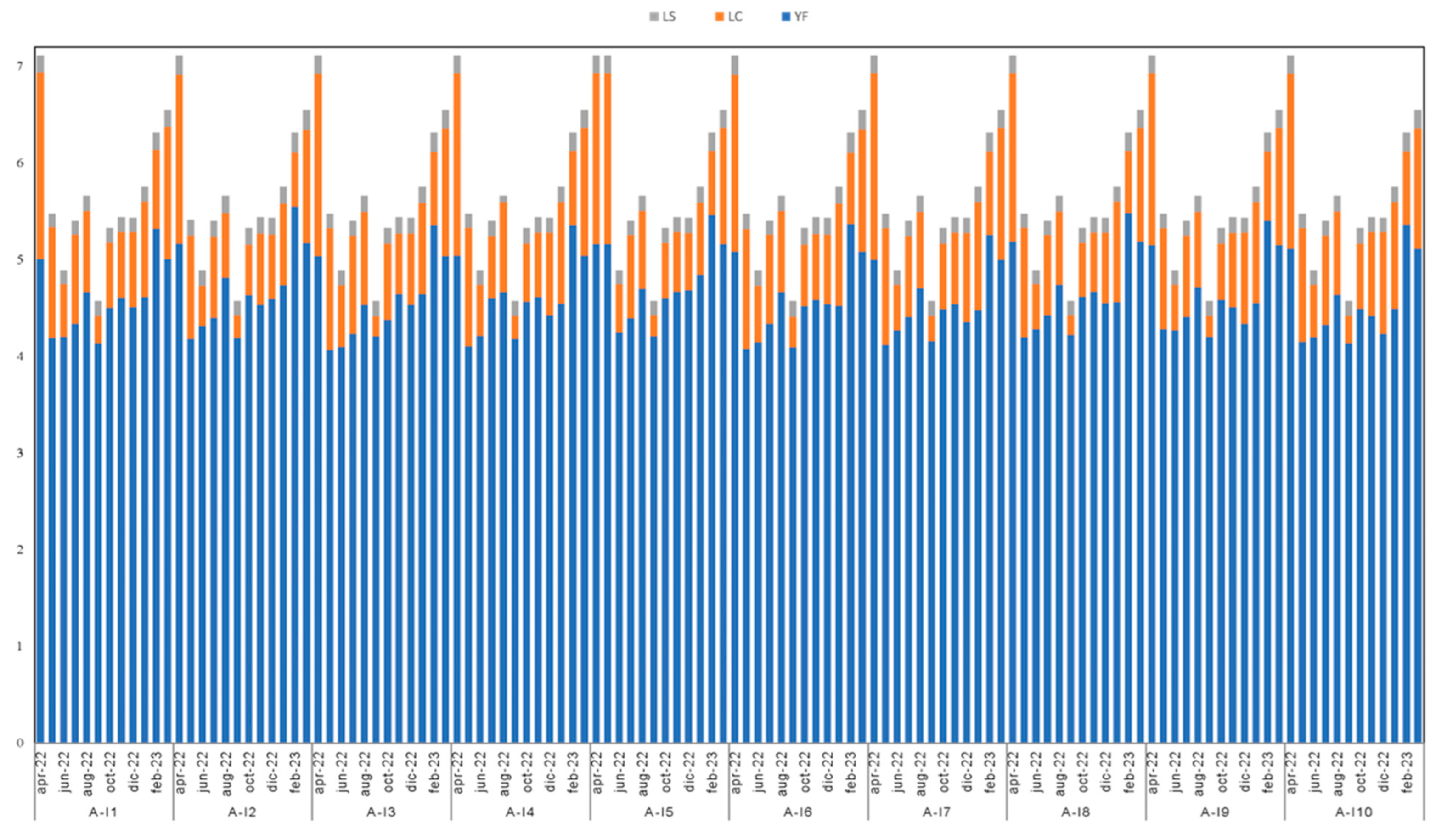

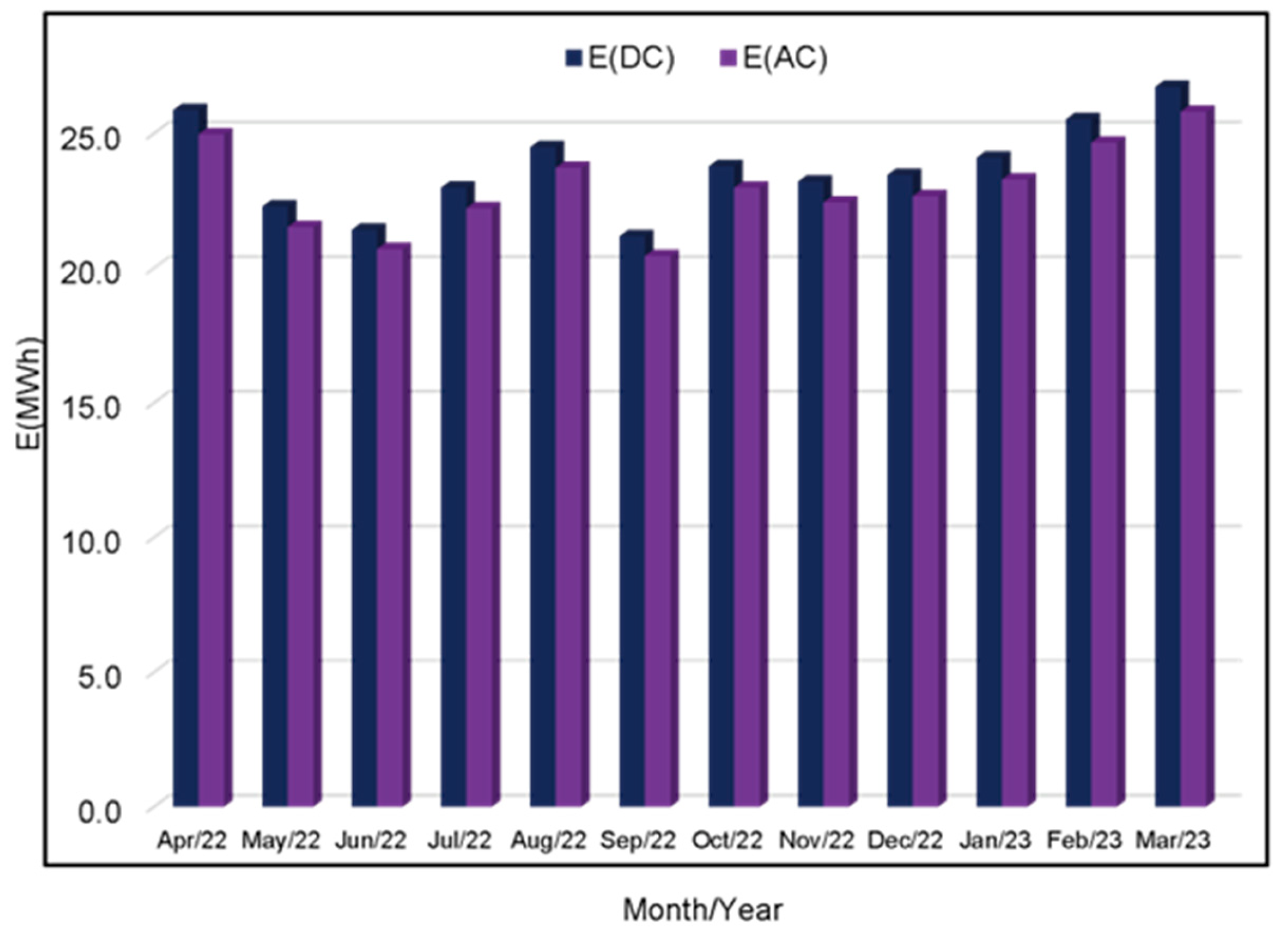

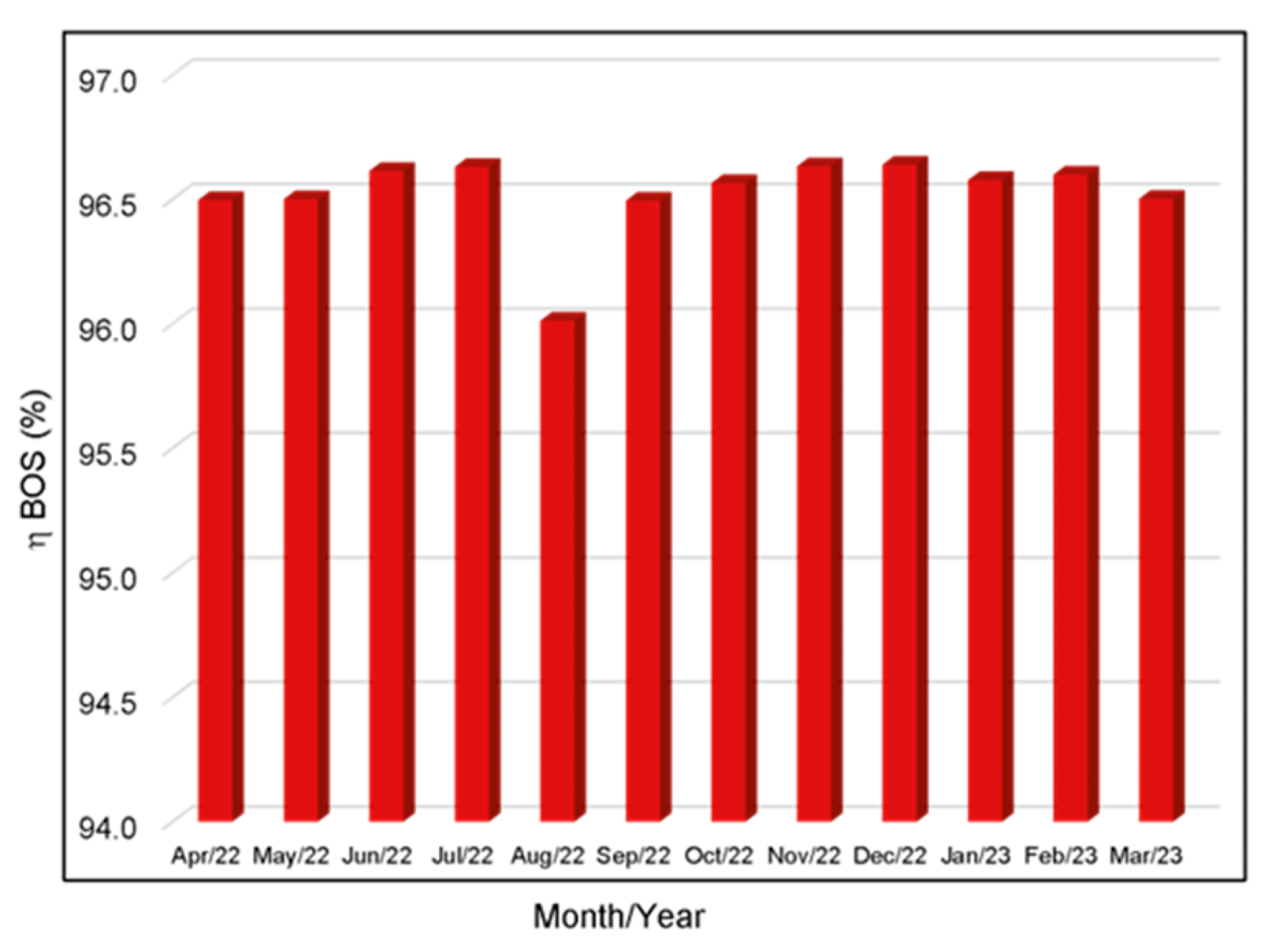
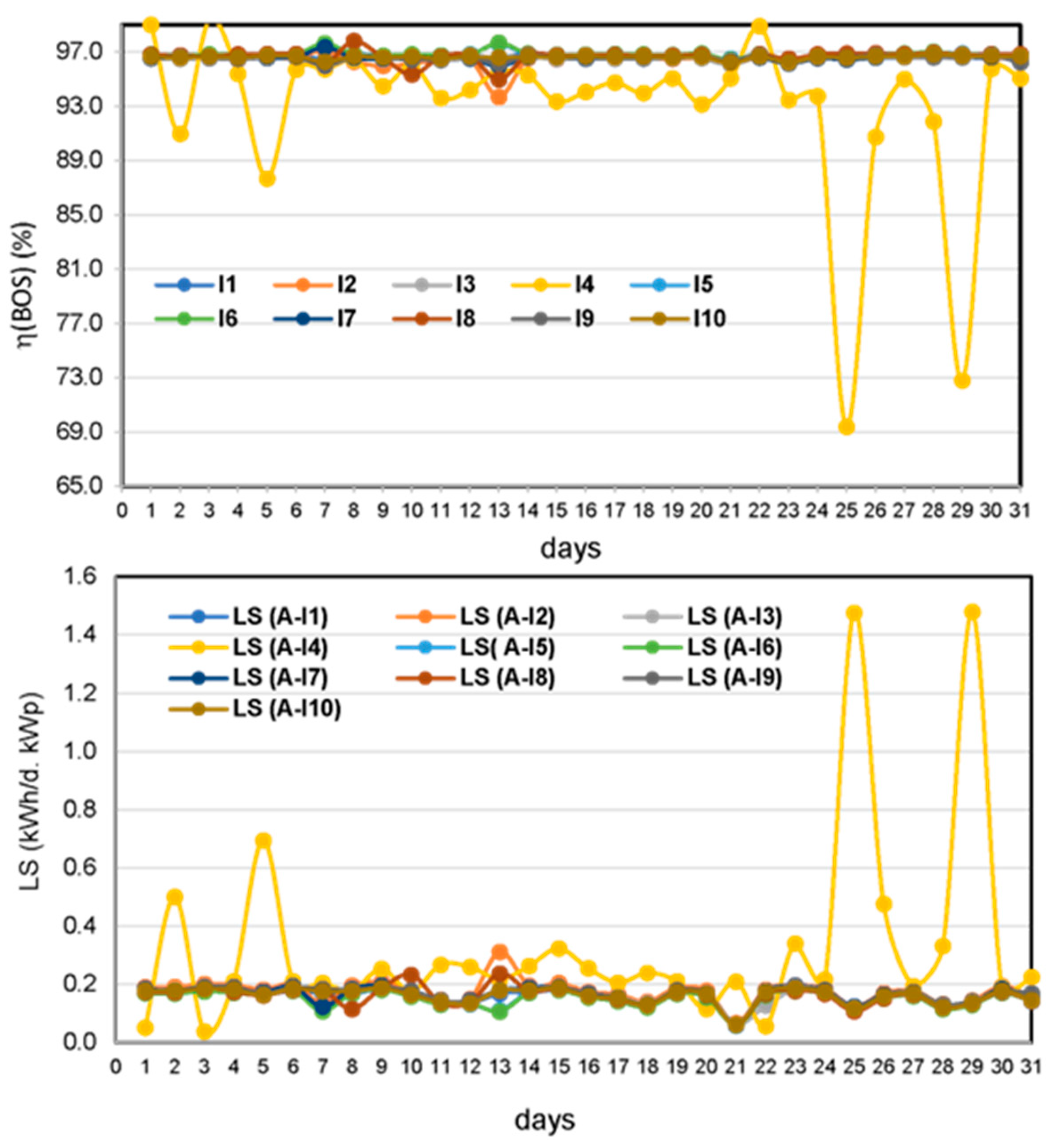
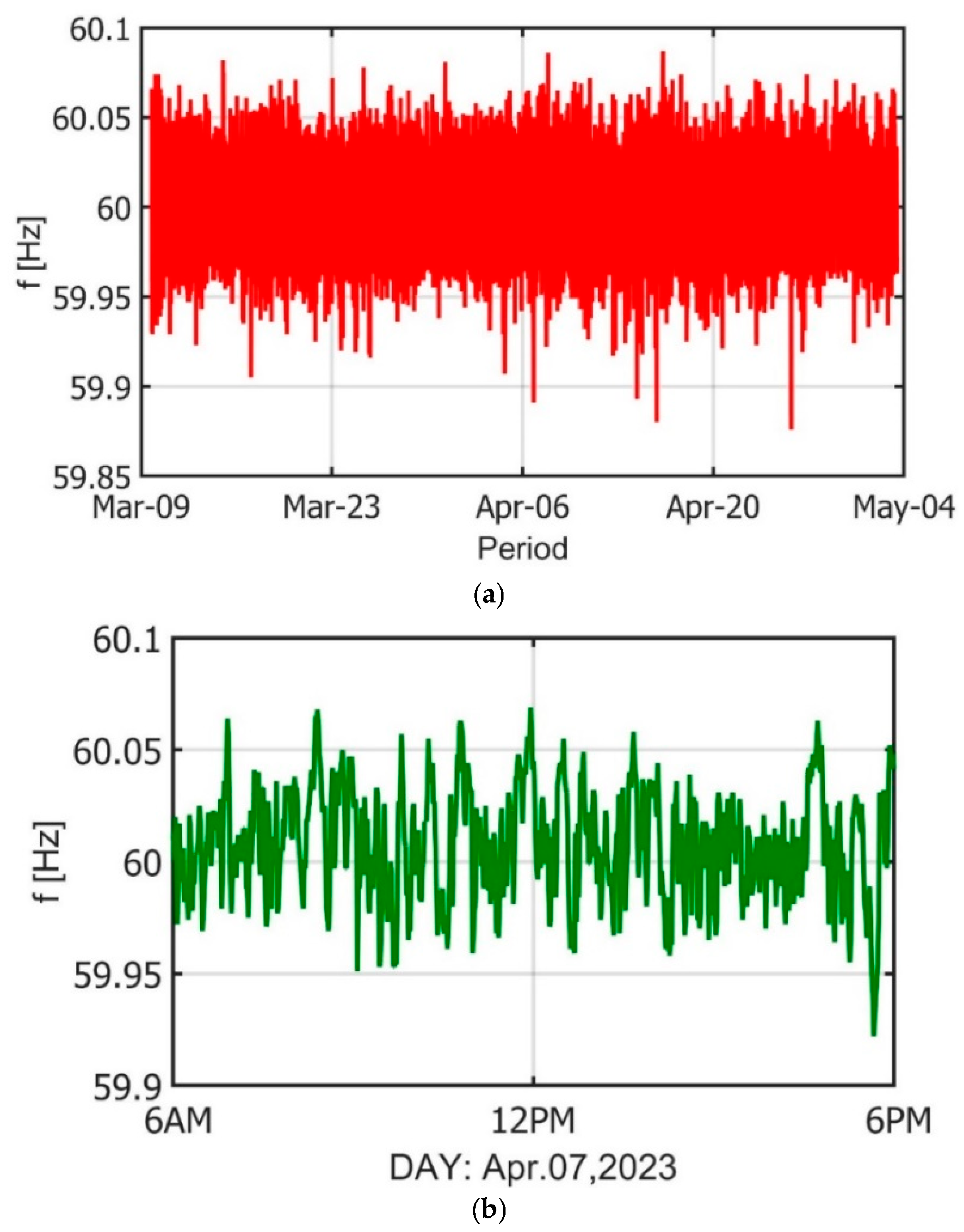
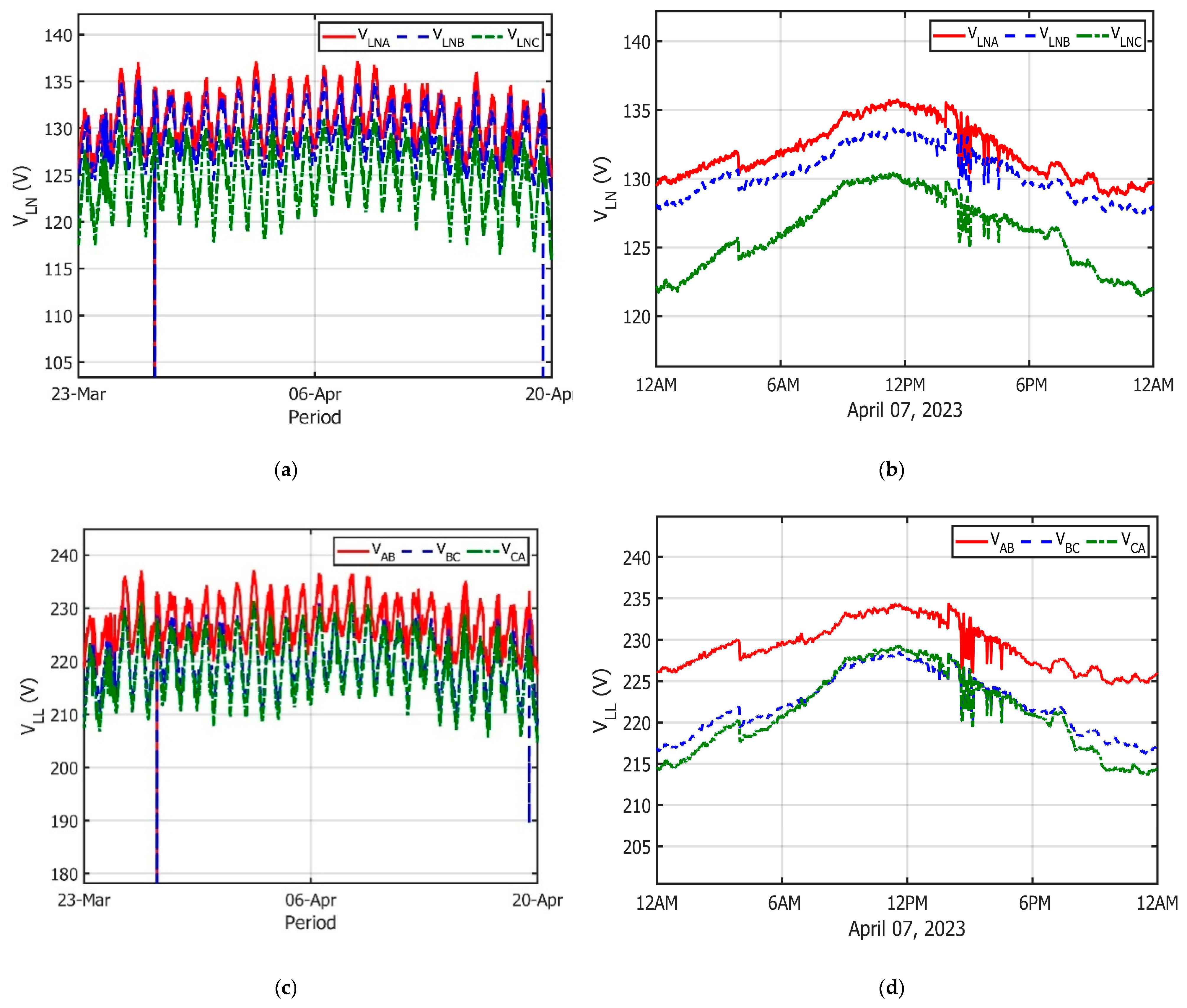

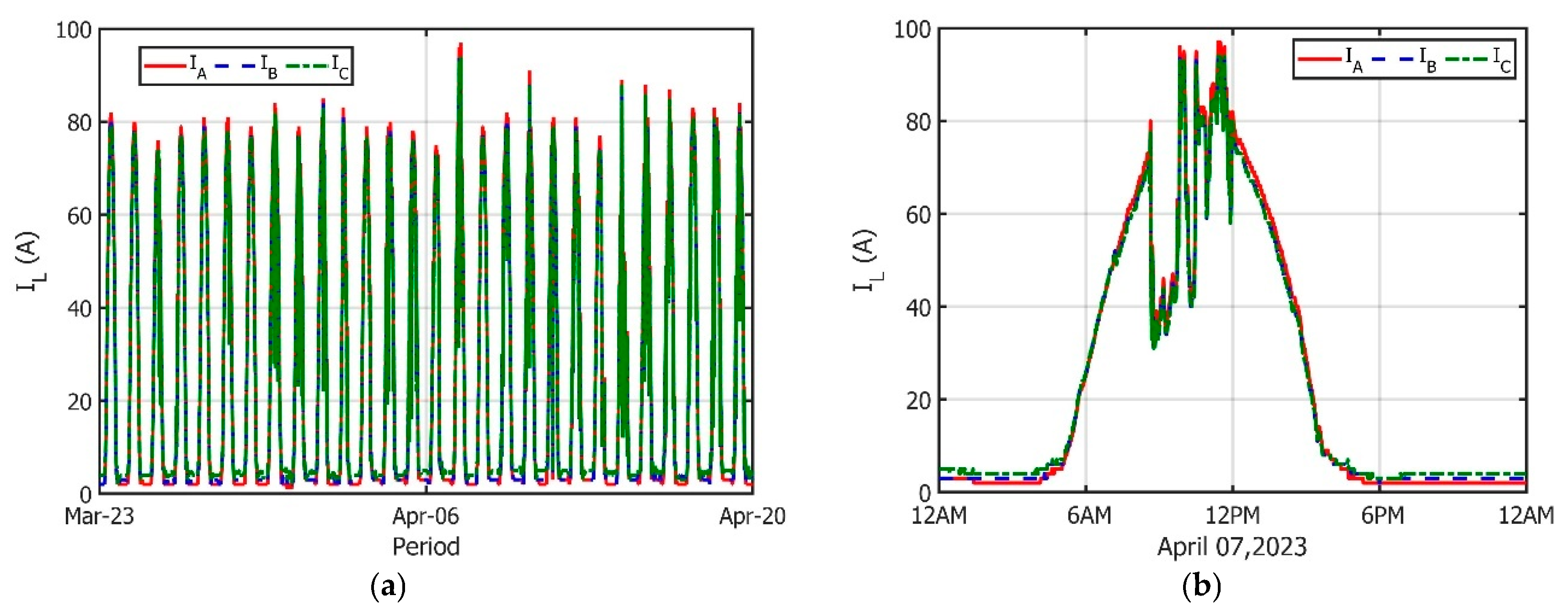
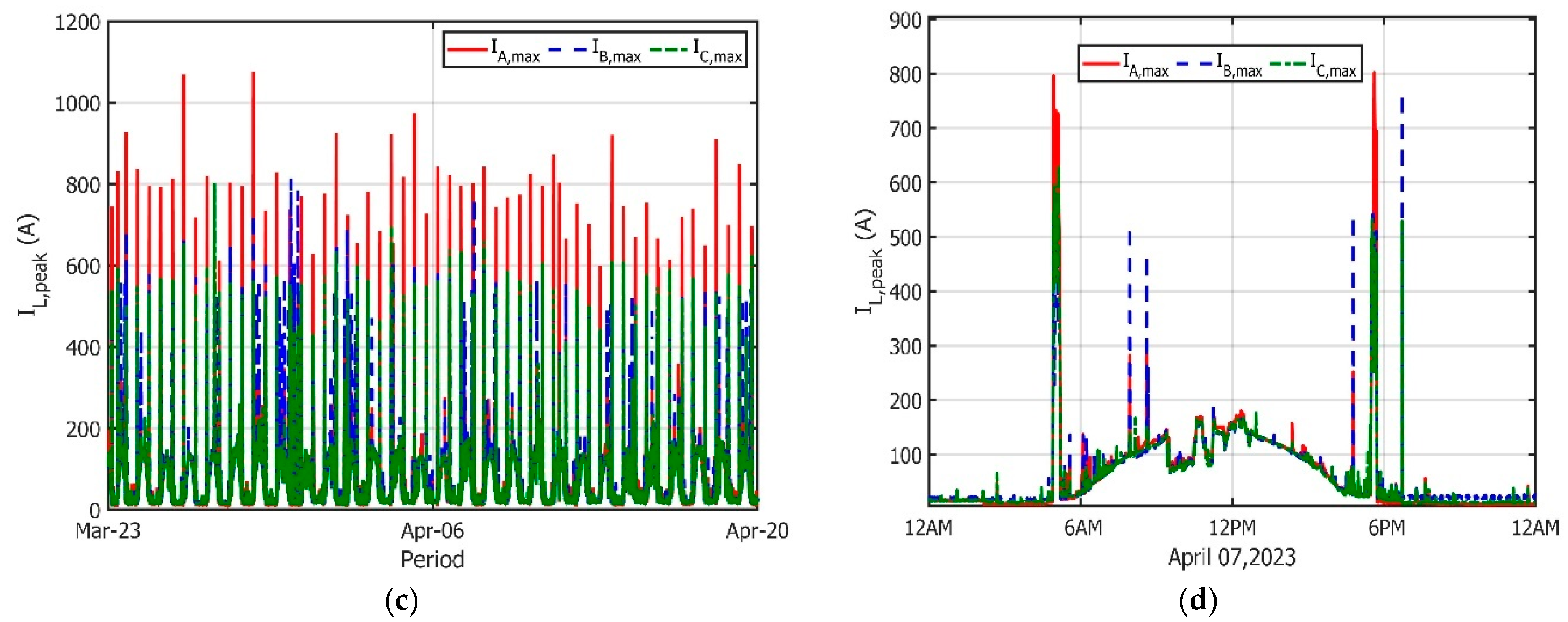
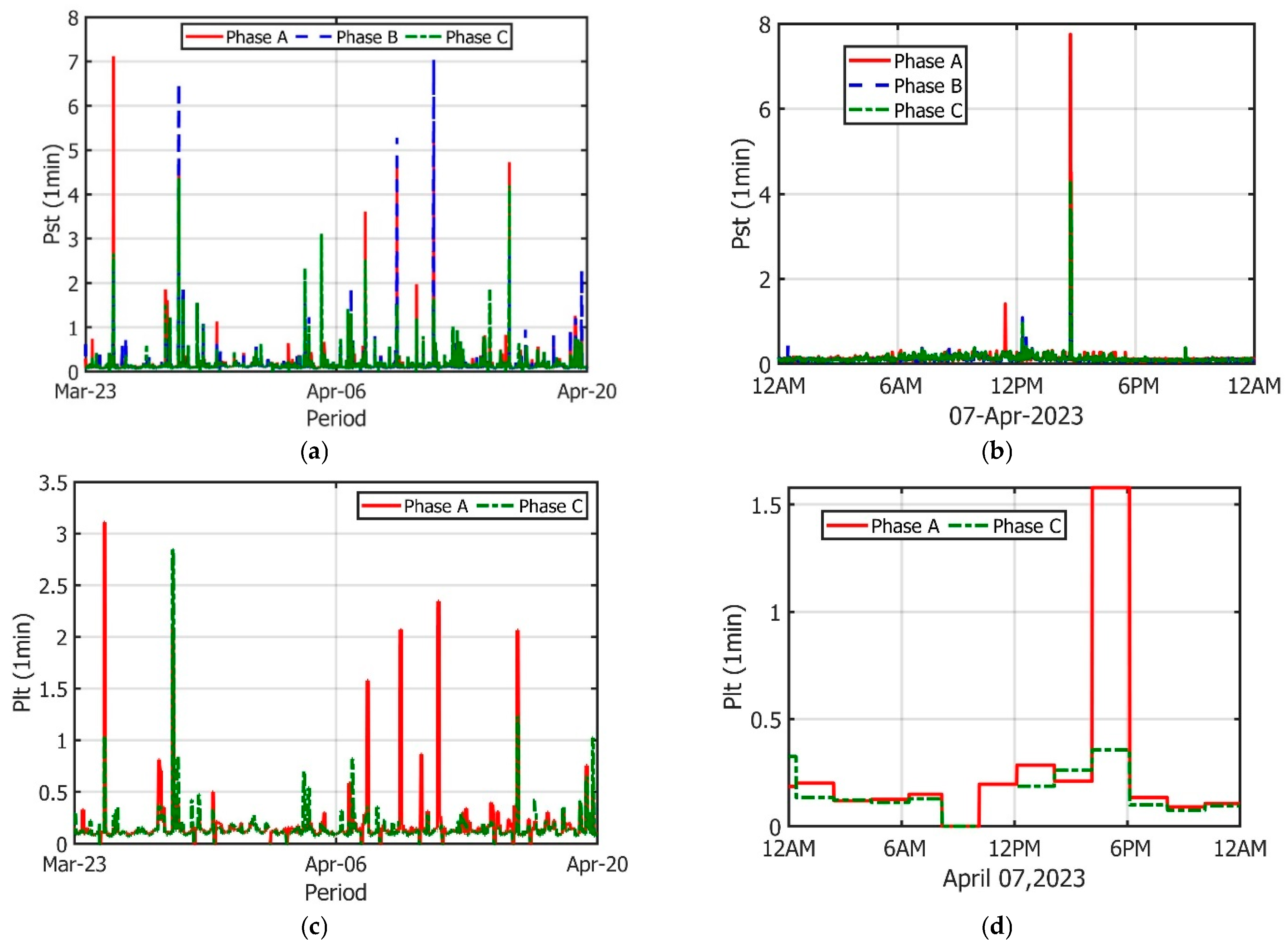
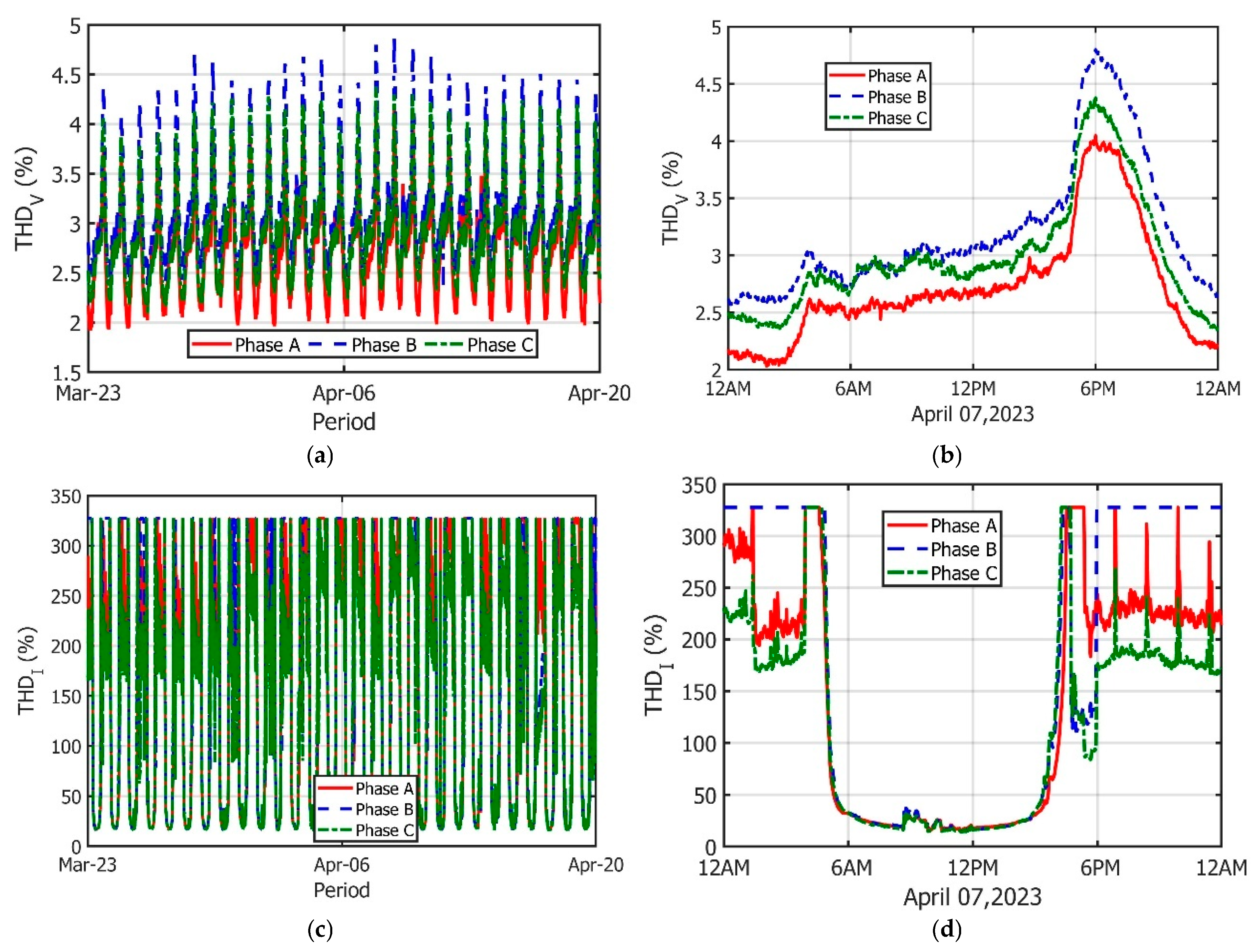
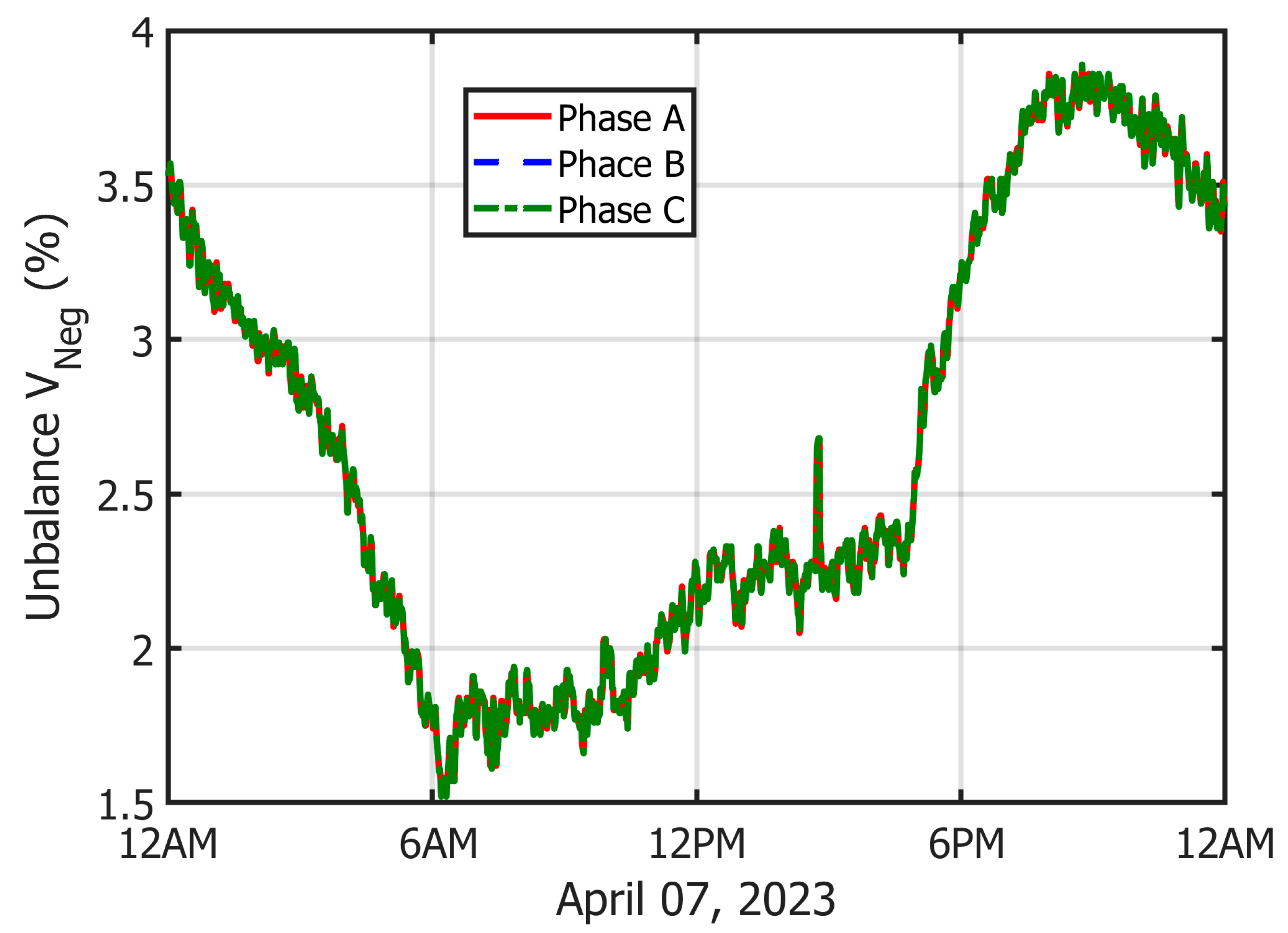
| PV Parameters | Array | Photovoltaic Modules |
|---|---|---|
| Maximum power at STC (Pmax) | 16.32 kWp | 340 Wp |
| Voltage (Vmpp) | 457.8 V | 38.15 V |
| Current (Impp) | 35.64 A | 8.91 A |
| Open circuit voltage | 556.92 V | 46.41 |
| Short circuit current | 37 A | 9.25 A |
| Photovoltaic System | ||
| Maximum power at STC (Pmax) | 163.2 kWp | |
| Requirement | Parameter | Limit |
|---|---|---|
| Maximum unbalance (%) | Voltage (VNeg) | 3% |
| Current (I) | 5% | |
| Maximum voltage variations ΔV/V (%) for low voltages V ≤ 1 kV | Variations/min | ΔV/V (%) |
| 0.0–0.0083 | 3.50% | |
| 0.0084–0.0667 | 3.00% | |
| 0.668–0.5 | 3.50% | |
| 0.501–2.0 | 2.00% | |
| 2.001–10.0 | 1.75% | |
| 10.001–30.0 | 1.25% | |
| 30.001–60.0 | 1.00% | |
| 60.001–240.0 | 0.75% | |
| 240.001–600.0 | 0.50% | |
| 600.001–1800.0 | 0.25% | |
| Flickers | Short term (Psti) | 0.90 |
| Long term (Plti) | 0.70 | |
| Harmonic distortion | THDV | <5.0% |
| Even harmonics | ||
| 3rd to 9th | <4.0% | |
| 11th to 15th | <2.0% | |
| 17th to 21st | <1.5% | |
| 23rd to 33rd | <0.6% | |
| Odd harmonics | ||
| 2nd to 8th | <1.0% | |
| 10th to 32nd | <4.0% | |
| <2.0% | ||
| <1.5% | ||
| <0.6% | ||
| <1.0% | ||
| <0.6% |
| Month | EAC (kWh) | EDC (kWh) | ηA (%) | ηA–I (%) | ηBOS (%) |
|---|---|---|---|---|---|
| Apr/22 | 24,966.916 | 25,869.153 | 13.045 | 12.590 | 96.497 |
| May/22 | 21,527.532 | 22,291.048 | 13.754 | 13.278 | 96.501 |
| Jun/22 | 20,708.606 | 21,426.391 | 15.767 | 15.235 | 96.614 |
| Jul/22 | 22,219.635 | 22,990.012 | 14.751 | 14.256 | 96.631 |
| Aug/22 | 23,721.189 | 24,492.104 | 14.978 | 14.486 | 96.013 |
| Sep/22 | 20,455.029 | 21,188.969 | 16.367 | 15.799 | 96.495 |
| Oct/22 | 22,982.071 | 23,784.780 | 15.467 | 14.940 | 96.566 |
| Nov/22 | 22,439.423 | 23,219.327 | 15.298 | 14.784 | 96.633 |
| Dec/22 | 22,672.128 | 23,459.601 | 15.183 | 14.673 | 96.640 |
| Jan/23 | 23,290.344 | 24,103.768 | 14.676 | 14.181 | 96.577 |
| Feb/23 | 24,661.336 | 25,529.335 | 15.636 | 15.104 | 96.600 |
| Mar/23 | 25,802.598 | 26,733.830 | 14.212 | 13.717 | 96.502 |
| Month/Year | (kWh/d.kW) | PR | |||||||
|---|---|---|---|---|---|---|---|---|---|
| Mean | StD | CV (%) | Mean | StD | CV (%) | Mean | StD | CV (%) | |
| Apr/22 | 7.11 | 0.28 | 3.93 | 5.10 | 0.48 | 9.69 | 0.719 | 0.079 | 11.00 |
| May/22 | 5.64 | 1.42 | 25.53 | 4.26 | 1.29 | 30.49 | 0.758 | 0.142 | 18.71 |
| Jun/22 | 4.89 | 1.12 | 22.64 | 4.23 | 0.97 | 22.70 | 0.869 | 0.101 | 11.63 |
| Jul/22 | 5.41 | 0.84 | 15.28 | 4.39 | 0.81 | 18.29 | 0.814 | 0.100 | 12.33 |
| Aug/22 | 5.66 | 0.60 | 10.50 | 4.69 | 0.82 | 17.77 | 0.827 | 0.129 | 15.78 |
| Sep/22 | 4.58 | 1.12 | 24.18 | 4.18 | 1.22 | 28.86 | 0.902 | 0.146 | 16.31 |
| Oct/22 | 5.33 | 1.24 | 27.26 | 4.54 | 1.18 | 28.92 | 0.853 | 0.172 | 20.07 |
| Nov/22 | 5.44 | 0.76 | 13.83 | 4.58 | 0.90 | 19.54 | 0.844 | 0.155 | 18.42 |
| Dec/22 | 5.44 | 0.70 | 12.64 | 4.48 | 0.37 | 8.94 | 0.837 | 0.129 | 15.46 |
| Jan/23 | 5.76 | 0.75 | 12.87 | 4.60 | 0.58 | 12.93 | 0.809 | 0.120 | 14.76 |
| Feb/23 | 6.32 | 0.55 | 8.54 | 5.40 | 0.21 | 4.20 | 0.862 | 0.094 | 10.89 |
| Mar/23 | 6.55 | 0.76 | 11.47 | 5.10 | 0.49 | 9.69 | 0.783 | 0.064 | 8.23 |
Disclaimer/Publisher’s Note: The statements, opinions and data contained in all publications are solely those of the individual author(s) and contributor(s) and not of MDPI and/or the editor(s). MDPI and/or the editor(s) disclaim responsibility for any injury to people or property resulting from any ideas, methods, instructions or products referred to in the content. |
© 2025 by the authors. Licensee MDPI, Basel, Switzerland. This article is an open access article distributed under the terms and conditions of the Creative Commons Attribution (CC BY) license (https://creativecommons.org/licenses/by/4.0/).
Share and Cite
Vázquez Vázquez, M.; Iracheta Cortez, R.; Acosta Banda, A.; Pantoja Enríquez, J.; Cortina Marrero, H.J.; Dorrego Portela, J.R.; Hechavarría Difur, L.; Hernández-Escobedo, Q.; Muñoz-Rodriguez, D.; Perea-Moreno, A.-J. Performance Evaluation of Grid-Connected Photovoltaic System Under Climatic Conditions of Isthmus of Tehuantepec. Resources 2025, 14, 179. https://doi.org/10.3390/resources14120179
Vázquez Vázquez M, Iracheta Cortez R, Acosta Banda A, Pantoja Enríquez J, Cortina Marrero HJ, Dorrego Portela JR, Hechavarría Difur L, Hernández-Escobedo Q, Muñoz-Rodriguez D, Perea-Moreno A-J. Performance Evaluation of Grid-Connected Photovoltaic System Under Climatic Conditions of Isthmus of Tehuantepec. Resources. 2025; 14(12):179. https://doi.org/10.3390/resources14120179
Chicago/Turabian StyleVázquez Vázquez, Michel, Reynaldo Iracheta Cortez, Adán Acosta Banda, Joel Pantoja Enríquez, Hugo Jorge Cortina Marrero, José Rafael Dorrego Portela, Liliana Hechavarría Difur, Quetzalcoatl Hernández-Escobedo, David Muñoz-Rodriguez, and Alberto-Jesus Perea-Moreno. 2025. "Performance Evaluation of Grid-Connected Photovoltaic System Under Climatic Conditions of Isthmus of Tehuantepec" Resources 14, no. 12: 179. https://doi.org/10.3390/resources14120179
APA StyleVázquez Vázquez, M., Iracheta Cortez, R., Acosta Banda, A., Pantoja Enríquez, J., Cortina Marrero, H. J., Dorrego Portela, J. R., Hechavarría Difur, L., Hernández-Escobedo, Q., Muñoz-Rodriguez, D., & Perea-Moreno, A.-J. (2025). Performance Evaluation of Grid-Connected Photovoltaic System Under Climatic Conditions of Isthmus of Tehuantepec. Resources, 14(12), 179. https://doi.org/10.3390/resources14120179








